In the Qur’an, as mentioned in earlier pages, Allah summons people to investigate nature and see the "signs" therein. All animate and inanimate beings in the universe are full of signs revealing that they are "made", and they demonstrate the power, knowledge and art of their "Creator". Man is responsible for identifying these signs by using his wisdom, and for paying reverence to Allah.
There are also some living beings to which Allah specifically refers in the Qur’an. The gnat is one of these animals. In the 26th verse of Surat al-Baqarah, the gnat is mentioned:
Allah is not ashamed to make the example of a gnat or of an even smaller thing. As for those who believe, they know it is the truth fom their Lord. But as for those who reject, they say, "What does Allah mean by this example?" He misguides many by it and guides many by it. But He only misguides the degenerate.
Considered as an ordinary, insignificant living being, even the gnat is worthy of being examined and pondered since it bears the signs of Allah. This is why "Allah is not ashamed to make the example of a gnat or of an even smaller thing".
 |
| Allah is not ashamed to make the example of a gnat or of an even smaller thing. As for those who believe, they know it is the truth from their Lord. But as for those who reject, they say, "What does Allah mean by this example?" He misguides many by it and guides many by it. But He only misguides the degenerate. |
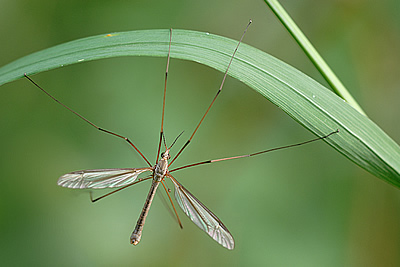 |
What is generally known about gnats is that they are bloodsuckers and feed on blood. This, however, is not quite correct, because not all gnats suck blood but only females. Besides, the females suck blood not because of their need for food. Both male and female gnats feed on the nectar from flowers. The only reason female gnats, unlike the males, suck blood is their need for the proteins found in blood which help their eggs to develop. In other words, the female gnat sucks blood just to secure the perpetuation of its species.
The developmental process is one of the most amazing and admirable sides of the gnat. The short story of the transformation of a living being from a tiny larva through many different phases into a gnat is as follows:
Gnat eggs, which are fed by blood to develop, are deposited on damp leaves or dried ponds by the female gnat during summer or autumn. Prior to this, the mother initially inspects the ground thoroughly by using the delicate receptors under her abdomen. Upon finding a convenient place, she starts to deposit her eggs. The eggs, which are less than 1 mm in length, are arranged in a row either in groups or one by one. Some species deposit their eggs in a form, which is joined together like a raft. Some of these egg groups contain about 300 eggs.
The neatly placed white eggs soon start to darken, and they turn completely black in a couple of hours. This dark colour provides protection for the larvae by preventing them from being noticed by other insects and birds. Apart from the eggs, the skin colours of some other larvae also change according to their surroundings, and this helps to protect them.
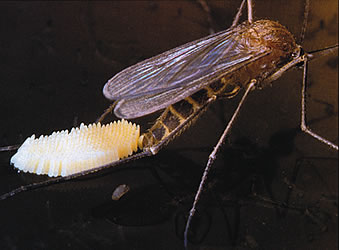 | 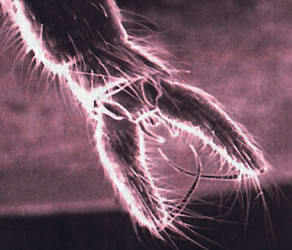 |
Special Pincers For Mating | |
| A male gnat mature enough to mate uses its antennae, i.e. its hearing organs, to find its female. The antennae of male gnats have different functions from those of females. Thin feathers at the end of their antennae are highly sensitive to sounds emitted by female gnats. Right beside the sexual organs of the male gnat, there are appendages, which help him to grab the female while mating in the air. Male gnats fly in groups that seem like clouds and when a female gnat enters the group, the male who succeeds in grabbing the female mates with her during flight. Mating does not take long and the male gnat goes back to his group after mating. From that moment, the female gnat needs blood for the development of her eggs. | |
The larvae change colours by making use of certain factors after quite complicated chemical processes. No doubt, neither the eggs, nor the larvae, nor the mother gnat is aware of the processes behind the colour changes during the gnat’s different developmental stages. It is out of the question for these living beings themselves to make this system or for this system to form by coincidence. Gnats have been created with these systems from the moment they first appeared.
 |  |
| Gnats during their pupal stage | |
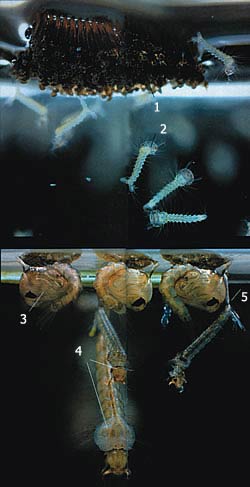 |
Respiratory System: |
| The respiratory system of the larva is based on a method whereby the larva breathes air by means of a hollow tube pushed up above the water surface. Meanwhile, larvae hang upside down under the water. A viscous secretion prevents water from leaking into the openings through which larvae breathe. |
When the incubation period is complete, larvae start to come out of the eggs almost simultaneously. The larvae, which feed continuously, grow quickly. Soon, their skins become too tight, not allowing them to grow any further. This indicates that it is time for the first change of skin. In this phase, the hard and brittle skin breaks easily. Before the gnat larva fully completes its development, it changes its skin two more times.
The method used for feeding the larvae is rather astonishing. The larvae make small whirlpools in the water with their two fan-shaped appendages made up of feathers, and thus make bacteria and other micro-organisms flow towards their mouths. The respiration of the larvae, which repose upside down in water, takes place through an aerial tube similar to the "snorkel" used by divers. A viscous solution secreted by their bodies prevents water from leaking into the openings through which they breathe. Briefly, this living being survives through the inter-relationship and interplay of many delicate balances. If it did not have an aerial tube, it could not survive; if it did not have a viscous secretion, its respiratory tube would fill with water. The formation of these two systems at two different times would cause the animal to die at this stage. This proves that the gnat has all its systems intact, that is, it was created.
The larvae change their skin once more. The last change of skin is rather different from the others. In this stage, larvae pass onto the final stage of their maturation, the "pupal stage". The shell they are placed in becomes quite tight. This shows that it is time for the larvae to emerge from this shell. Such a different creature comes out of the shell that it is indeed hard to believe that these two are different developmental phases of the same being. As seen, this transformation process is far too complicated and delicate to have been designed either by the larva or by the female gnat...
During this last stage of transformation, the animal faces the danger of being choked, as its respiratory openings, reaching above the water through an aerial tube, would be closed. However, from that stage on, respiration will not be done by means of these holes, but by means of two tubes newly emerging on the anterior of the animal. This is why these tubes rise to the surface of the water prior to the change of skin. The gnat in the pupa cocoon has now become mature. It is ready to fly with all its organs and organelles such as antennae, trunks, feet, chest, wings, abdomen and its large eyes.
The pupa cocoon is torn at the top. The greatest risk at this stage is the leakage of water into the cocoon. However, the torn top of the cocoon is covered with a special viscous liquid protecting the gnat’s head from contact with the water. This moment is extremely important. Because even a soft wind may bring its death by causing it to fall into the water, the gnat has to climb on the water with its feet only touching the water surface. It succeeds.
How is it that the first gnat attained the "ability" to go through such a transformation? Could it be that a larva "decided" to transform into a gnat after changing skin three times? Absolutely not! It is quite evident that this tiny living being, which Allah gives as an example, has specifically been created this way.
 |
| While the gnat comes out of the water, its head should not contact the water at all, because even one breathless moment may result in the gnat's choking. Even a breeze or a tiny turbulence on the water surface could be fatal for the gnat. |
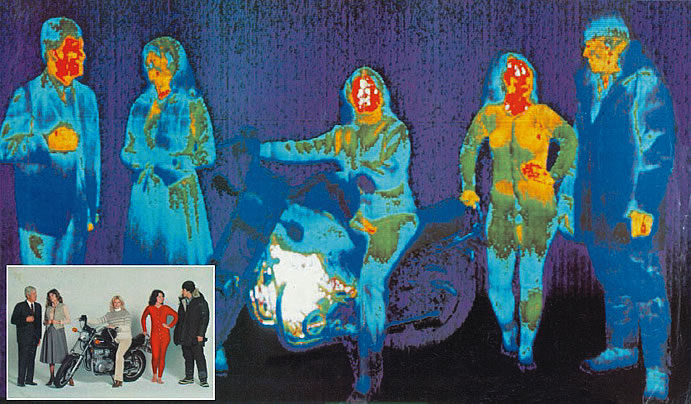 |
How Gnats Perceive The Outside WorldGnats are equipped with extremely sensitive heat receptors. They perceive the things around them in different colours depending on their heat, as in the picture on the right. As its perception is not dependent on light, it is quite easy for the gnat to spot blood vessels even in a dark room. The heat receptors of the gnat are sensitive enough to detect heat differences as small as 1/1,000o C. |
 |
| The gnat has nearly one hundred eyes. As compound eyes, these are placed on the top of its head. In the picture above, the cross-sections of three of these eyes are shown.On the right, we see how the image of an object is transmitted to the brain from the eye. |
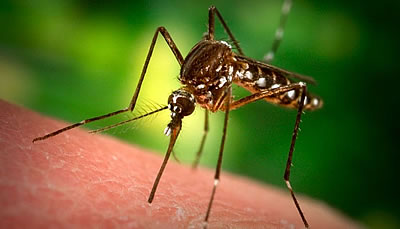 |
The gnat’s technique of "blood-sucking" depends on a complex system in which unbelievably detailed structures work together.
After the gnat lands on its target, it first detects a spot by means of the lips in its proboscis. The syringe-like ‘sting’ of the gnat is protected by a special sheath, which is stripped back during the blood-sucking process.
The gnat does not pierce the skin, as assumed, by thrusting its proboscis into it with pressure. Here, the main task falls to the upper jaw, which is as sharp as a knife, and the mandible on which there are teeth bent backwards. The gnat moves its mandible forwards and backwards like a saw and cuts the skin with the help of the upper jaws. When the sting, inserted through this cut in the skin, reaches to the blood vessel, the drilling ends. Now it is time for the gnat to suck blood.
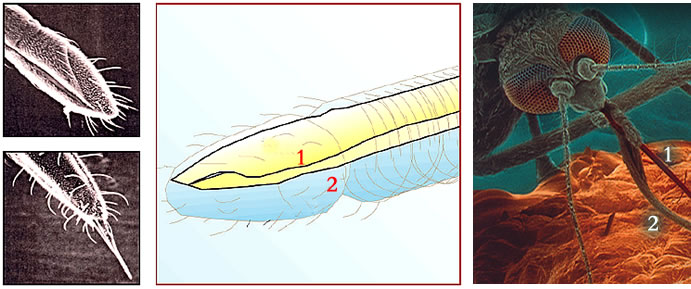 | |
| 1. Sting | 2. Sheath |
However, as we know, the slightest harm to the vessels causes the human body to secrete an enzyme that makes the blood clot and stops its leakage. This enzyme should create a problem for the gnat, because the body should also react to the hole opened by the gnat, causing the blood at this spot to clot immediately and the wound to be repaired. That would mean that the gnat could not suck any blood.
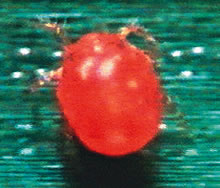 |
| The photograph is of a tiny animal that lives as a parasite on gnats. When we consider that apart from the excellent systems of the gnat, such as feeding, reproduction, respiration and blood circulation, only a small part of which we could examine here, this lice also has complex systems and organic functions, we can better comprehend the boundlessness of the signs of Allah. |
But the problem is eliminated for the gnat. Before the gnat starts sucking blood, it injects a special liquid secreted in its body into the cleavage opened in the living being it has stung. This liquid neutralises the enzyme that causes the clotting of blood. Thus, the gnat sucks the blood it needs without the problem of clotting. The itching and swelling formed on the spot bitten by the gnat is caused by this liquid that prevents clotting.
This is surely an extraordinary process and it brings the following questions to mind:
1) How does the gnat know that there is a clotting enzyme in the human body?
2) In order to produce a neutralising secretion in its own body against that enzyme, it needs to know the chemical structure of the enzyme. How could this be possible?
3) Even if it somehow attained such knowledge (!), how could it produce the secretion in its own body and make the "technical rigging" needed to transfer it to its proboscis?
The answer to all these questions is obvious: it is not possible for the gnat to perform any of the above. It neither has the required wisdom, knowledge of chemistry, or the "laboratory" environment to produce the secretion. What we talk about here is only a gnat of a few millimetres in length, without consciousness or wisdom, that is all!
It is quite clear that Allah, "Lord of the heavens and of the earth, and of all that is between them", has created both the gnat and man, and donated such extraordinary and marvellous features to the gnat.
 |
| Everything in the heavens and the earth glorifies Allah. |